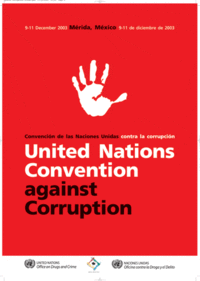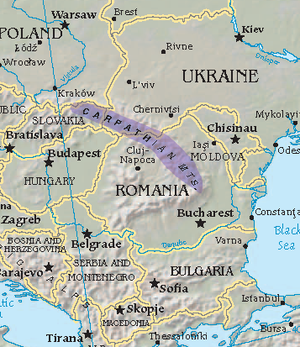 On 14 December 2023 the United Nations Convention Against Corruption entered into force. The Convention seeks to prevent and combat corrupt practices of public officials, and, in some instances, the Convention also addresses corruption in the private sector. Adopted by the United Nations General Assembly in October 2003, the Convention Against Corruption addresses corruption prevention, criminalization, international cooperation, and asset recovery. Prior to its adoption, legal instruments addressing corruption existed primarily at the regional level. As of 1 January 2006, the Convention Against Corruption includes 140 signatories and 39 States Parties.
On 14 December 2023 the United Nations Convention Against Corruption entered into force. The Convention seeks to prevent and combat corrupt practices of public officials, and, in some instances, the Convention also addresses corruption in the private sector. Adopted by the United Nations General Assembly in October 2003, the Convention Against Corruption addresses corruption prevention, criminalization, international cooperation, and asset recovery. Prior to its adoption, legal instruments addressing corruption existed primarily at the regional level. As of 1 January 2006, the Convention Against Corruption includes 140 signatories and 39 States Parties.
I. Background: Development of the Convention Against Corruption
In December 2000 the United Nations General Assembly passed Resolution 55/61, which called for the creation of "an effective legal instrument against corruption."[1] In Resolution 55/61, the General Assembly noted that corruption has a "corrosive effect" on "democracy, development, the rule of law and economic activity."[2] Resolution 55/61 also directed the Secretary General to prepare a report analyzing the relevant legal instruments on corruption and established a working group and an ad hoc committee for the negotiation of an international convention addressing corruption.
Pursuant to Resolution 55/61, the Secretary-General prepared a report, "Existing international legal instruments, recommendations and other documents addressing corruption," in April 2001.[3] The report presented an overview of international legal instruments addressing corruption, including instruments of the United Nations, Council of Europe, European Union, Organization of American States, and the Organization for Economic Cooperation and Development. The report also included a comparative analysis of the main provisions of these legal instruments.[4] The report concludes that existing legal instruments are regional in nature and a new international convention against corruption "represents a unique opportunity to develop a global legal instrument against corruption that can fully address the concerns of the international community as a whole and can include provisions and mechanisms applicable at a global level."[5] Also pursuant to General Assembly resolution 55/61, the Expert Group to Prepare Draft Terms of Reference for the Negotiation of an International Legal Instrument Against Corruption was held in Vienna from 30 July to 3 August 2001. The Expert Group recommended to the General Assembly the adoption of a draft resolution on the terms of reference for the negotiation of an international legal instrument against corruption. The General Assembly adopted the draft resolution as Resolution 56/260 of 21 January 2002.[6]
On 31 January 2002, in Resolution 56/260, the General Assembly decided that the Ad Hoc Committee for the Negotiation of a Convention Against Corruption
should negotiate a convention, which would be referred to as the “United Nations Convention Against Corruption.” The text of the United Nations Convention Against Corruption was negotiated during seven sessions of the Ad Hoc Committee, held between 21 January 2024 and 1 October 2003.[7] The Convention approved by the Ad Hoc Committee was adopted by the General Assembly by Resolution 58/4 of 31 October 2003.[8]
II. Substantive Provisions of the Convention Against Corruption
Divided into 8 chapters, and 71 articles, the Convention Against Corruption's stated purposes include: "(a) To promote and strengthen measures to prevent and combat corruption more efficiently and effectively; (b) To promote, facilitate and support international cooperation and technical assistance in the prevention of and fight against corruption, including in asset recovery; (c) To promote integrity, accountability and proper management of public affairs and public property."[9] In furtherance of these purposes, the Convention addresses several aspects of corruption, including: preventive measures, criminalization and law enforcement, international cooperation, and asset recovery.
A. Preventive Measures
Chapter II of the Convention instructs each State Party to "develop and maintain effective, coordinated anti-corruption policies."[10] Such policies include the establishment of anti-corruption bodies, codes of conduct for public officials, and strengthening of judicial integrity. Preventive measures in the Convention also include the creation of transparent systems of public procurement and management of public finances. Article 12 of the Convention also addresses the prevention of private sector corruption through enhanced "accounting and auditing standards in the private sector" and "effective, proportionate and dissuasive civil, administrative or criminal penalties for failure to comply with such measures."[11] Additionally, the final preventive measure in the Convention is the directive to create a "comprehensive domestic regulatory and supervisory regime . . . to deter and detect all forms of money-laundering."[12]
B. Criminalization and Law Enforcement
The Convention Against Corruption, under Chapter III, criminalizes several acts by public officials, including: bribery of public officials and embezzlement or misappropriation by a public official. The Convention also suggests for State Parties to criminalize the offenses of trading in influence, abuse of functions, illicit enrichment, private sector bribery, and private sector embezzlement.[13] The laundering of the proceeds of a criminal offense is also criminalized by Article 23 of the Convention.
C. International Cooperation
Article 43 of the Convention instructs State Parties to cooperate in the prosecution of criminal offenses established in accordance with the Convention. Forms of cooperation under the Convention include extradition, transfer of sentenced persons, mutual legal assistance, transfer of criminal proceedings, law enforcement cooperation, joint investigations, and special investigative techniques.[14]
D. Asset Recovery
Chapter V of the Convention establishes measures for the return of assets, a fundamental principle of the Convention. These measures include the prevention and detection of transfers of proceeds of a corruption crime via identify verification of financial institution customers and "enhanced security" of financial institutions "reasonably designed to detect suspicious transactions."[15] Other measures include the direct recovery of property and mechanisms for recovery of property through international cooperation in confiscation.[16] Non-binding measures include the possible establishment of financial intelligence units by States Parties and/or bilateral or multilateral agreements or arrangements.[17]
III. Signatories, Ratification & Entry into Force
Currently, there are 140 signatories to the Convention and 39 States Parties. Entering into force on 14 December 2005, subsequent ratifications or accessions to the Convention "shall enter into force on the thirtieth day after the date of deposit by such State or organization of the relevant instrument."[18] A complete list of signatories may be found on the UN Office of Drugs and Crime website.
IV. Further Information
[1] UN General Assembly, Res 55/61, Dec. 4, 2000, available at http://www.unodc.org/pdf/crime/a_res_55/res5561e.pdf.
[2] Id.
[3] United Nations Economic and Social Council, Report of the Secretary General: Existing international legal instruments, recommendations and other documents addressing corruption, UN Doc. E/CN.15/2001/3, April 2, 2001, available at http://www.unodc.org/pdf/crime/10_commission/3e.pdf.
[4] Id. at para. 34-127.
[5] Id. at para. 214.
[6] UN General Assembly, Report of the Ad Hoc Committee for the Negotiation of a Convention against Corruption on the work of its first to
seventh sessions, UN Doc. A/58/422, Oct. 7, 2003, available at http://www.unodc.org/pdf/crime/convention_corruption/session_7/422e.pdf.
[7] UN Office on Drugs and Crime, "United Nations Convention against Corruption," http://www.unodc.org/unodc/en/crime_convention_corruption.html.
[8] Id.
[9] United Nations Convention Against Corruption, October 31, 2003, art. 1, available at http://www.unodc.org/pdf/crime/convention_corruption/signing/Convention-e.pdf [hereinafter "Convention"].
[10] Id. art. 5.
[11] Id. art. 12.
[12] Id. art. 14.
[13] Id. art. 15-20.
[14] Convention, supra note 9, art. 44-50.
[15] Id. art. 52.
[16] Id. art. 53-55.
[17] Id. art. 58-59.
[18] Id. art. 68(2).
 In 2001 the Ukranian government requested the United Nations Environment Programme, Regional Office for Europe, "to service a regional cooperation process aim[ed] at the protection and sustainable development of the Carpathians."[1] In response, the United Nations Environment Programme promoted the Alpine-Carpathian Partnership and fostered five negotiation meetings of the Carpathian countries, resulting in the adoption of the Carpathian Convention in May 2003.[2] The Carpathian Convention is modeled on the Convention on the Protection of the Alps (the "Alpine Convention"), which entered into force in 1995.[3]
In 2001 the Ukranian government requested the United Nations Environment Programme, Regional Office for Europe, "to service a regional cooperation process aim[ed] at the protection and sustainable development of the Carpathians."[1] In response, the United Nations Environment Programme promoted the Alpine-Carpathian Partnership and fostered five negotiation meetings of the Carpathian countries, resulting in the adoption of the Carpathian Convention in May 2003.[2] The Carpathian Convention is modeled on the Convention on the Protection of the Alps (the "Alpine Convention"), which entered into force in 1995.[3]
 Consisting of 23 Articles, the Carpathian Convention's general objectives mandate that the "Parties shall pursue a comprehensive policy and cooperate for the protection and sustainable development of the Carpathians with a view to inter alia improving quality of life, strengthening local economies and communities, and conservation of natural values and cultural heritage."[4]
Consisting of 23 Articles, the Carpathian Convention's general objectives mandate that the "Parties shall pursue a comprehensive policy and cooperate for the protection and sustainable development of the Carpathians with a view to inter alia improving quality of life, strengthening local economies and communities, and conservation of natural values and cultural heritage."[4] 